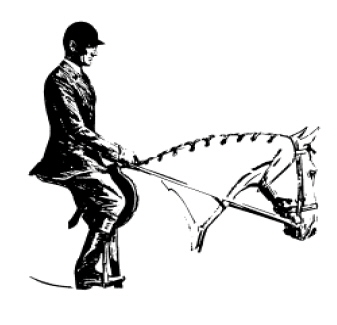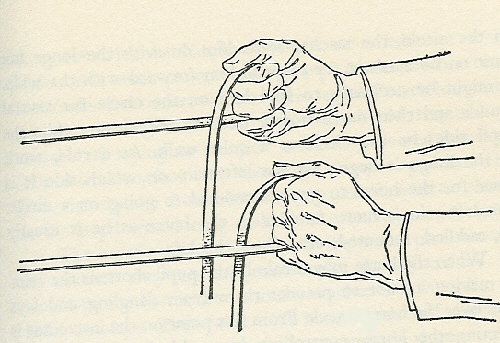IMEHA (International Model Equine Hobbyists Association) was an online photo showing site that existing until 2018. Included on the site were these guidebooks for judging and showing model horses in Performance classes. MEPSA has obtained permission to share the info contained in the guides.
Scoring :: Point Deducts :: Tack :: Rider :: Set-Up Options :: Photo Examples
A hunter pace is a form of competition involving horses and riders. In a hunter pace a trail is marked for horse and rider to follow. On the day of the competition, early in the morning, the hosts of the event send an experienced horse and rider to ride the trail as fast as it is safely possible to do so. This morning ride is called “the dead body run”, and it establishes two things:
- 1. that the trail is clear and safe for the competitors
- 2. The “pace time”
The pace time is the ideal time to safely but quickly ride the set trail. When the competitors arrive they send out teams of three or four to ride the trail. Checkpoints set along the ride ensure that the riders are staying on course and are not overworking their horses. Each group of riders is timed. Riders are penalized for either riding too fast and beating the pace time, or too slow and taking longer than the pace time. The group to come closest to the pace time wins the competition, whether over or under the “pace” time.
Attire and tack are hunt seat but more relaxed. Hunter Pace is a laid-back event and often not strict on attire or tack. Many riders will wear hunt seat attire, but other times they will dress more like for cross country. Helmets and boots are required for most Hunter Pace events, with helmets required if the rider will be jumping.
Leg protection for the horse is optional.
No cross entering from Hunter Hack, Hunter Over Fences or Handy Hunter Classes.
You Score Hunter Pace on the following basis:
(a) The hunter pace horse should move in the same style as a working hunter. The class will be judged on style over fences, even hunting pace, flat work, manners and way of going. While a correct hunter travels with the poll level with, or slightly above the withers and with correct impulsion behind in hunter pace the horse may be less correct. A proper hunter’s head should not be carried behind the vertical, giving the appearance of intimidation, or be excessively nosed out, giving a resistant appearance but in hunter pace the standard is less.
(d) Scoring:
(1) To be judged on manners, way of going and style of jumping. Horses shall be credited with maintaining an even hunting pace that covers the course with free-flowing strides. Preference will be given to horses with correct jumping style that meet fences squarely, jumping at the center of fence.
If You Use A Doll Rider:
Rider should have a workmanship appearance, seat and hands, light and supple. Hand should be over and in front of horse’s withers, knuckles 30 degrees inside the vertical, hand slightly apart and making a straight line from the horse’s mouth to rider’s elbow. Method of holding reins is optional. All reins are to be picked up at the same time. Eyes should be up with shoulders back, toes slightly out and ankles flexed in. Heels should be down and calf or leg in contact with horse and slightly behind girth.
The rider should sit in a comfortable, balanced, and relaxed manner while maintaining an erect upper body with eyes up and looking forward.
The rider’s legs should have a slight bend and hang beneath the rider such that when viewed from a profile, a straight line (approximately) can be drawn through the rider’s ear, shoulder, hip and heel.
The irons should be placed under the balls of the feet and not under the toe or against the heel.
Toes should be turned only slightly out with ankles flexed in toward the horse.
The lower leg should be held such that light contact would be maintained with the horse.
Arms and hands should be held in a comfortable, relaxed manner with upper arms held in a straight line with the body. The elbow is bent such that the lower arm and hands are in a straight line to the bit.
Hands should be slightly over and in front of the withers with knuckles 30 degrees inside the vertical.
Position in Motion;
At the walk and slow trot, body should be vertical with slight motion in the saddle.
At a posting trot, the body should be inclined forward with slight elevation in the saddle.
At the canter, the body should be halfway between the posting trot and the walk.
At the gallop, and while jumping, the body should be at a similar inclination as when at a posting trot.
Extra Credit Should Be Given If:
(1) Rein contact is steady but a bit more relaxed than in other English style classes and disciplines. It is a ‘direct contact’ pull however. On a model entry this can be achieved by using sticky wax and makes the rein go in a direct straight line from the bit to the rider’s hand with no slack in the rein.
(2) Bight (Excess rein) of rein is draped on the right.
(3) Mane and tail braided with complementary color also should receive extra credit.
(4) an Entry Number is shown on saddle blanket or on rider’s back.
Points Should Be Deducted If:
(1) Model’s head is carried too high.
(2) Model displays excessive nosing out.
(3) Model displays an open mouth excessively.
(4) Rider uses spurs forward of the cinch.
(5) Model appears sullen, dull, lethargic, emaciated, drawn or overly tired.
(6) Reins are draped and not a direct contact.
Required Tack:
Forward seat (jumping saddle)either:
Close Contact
Eventing
All-purpose
Saddles are usually of brown leather, with a plain girth, usually of leather.
Hunter Pace is a laid-back event and often not strict on attire or tack. Many riders will wear hunt seat attire, but other times they will dress more like for cross country. Leg protection for the horse is optional.
Bridle with a plain cavesson (any type of noseband other than a plain cavesson is prohibited) and a simple, unadorned browband.
Snaffle bit, either a dee-ring, eggbutt, or full cheek design.
Pelham bits which include a curb chain and require two sets of reins are also legal
Bit converters are illegal.
Prohibited:
Standing Martingales are forbidden.
Rider:
Hunt seat attire or cross country attire. Short sleeve shirts allowed. Helmets and boots are required for most Hunter Pace events, with helmets required if the rider will be jumping.
Set-Up Options:
Footing Required:
- Dirt
- Sand
- No rock base
Backboard or Natural Setting (Natural Outdoor)
Examples of Hunter Pace Entries:
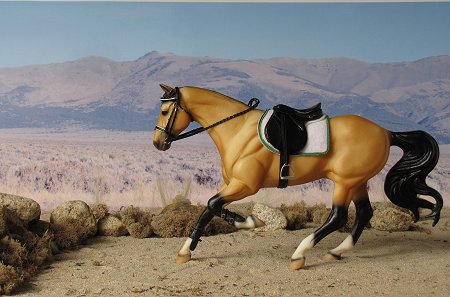
Champagne Supernova, shown as a buckskin Sporthorse gelding, is a OF Breyer Gem Twist special run, Competitor. Owned and shown by Mona McGraw.
Doll Rider Correct Seat and Hold the Reins Correctly:

The reins are held between the ring fingers and pinkies with the thumbs solidly on top as they exit the hands. The grip is firm. Close the fingers for optimum communication and safety. Hold the hands just above the horse’s withers, in front of the saddle. Tip the thumbs toward each other at a 45-degree angle. Bend the elbows just enough to create a straight line through the forearms, hands, and reins to the horse’s mouth.
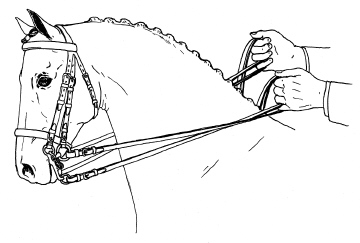
Double Bridle Reins – 2 and 2 Method. Most common handle hold in model horse hobby. It is advised that you put in your comment line what hold your set up is so that judge’s know you understand the three styles on holding the reins.

Double Bridle Reins – 3 in 1 Method. A true challenge for model horse hobbyists and doll rider’s with razor cut slips in the fingers of the hands. Left side curb goes directly back to hand and enters under ring finger with the left snaffle rein coming directly back and entering under the pinky finger with rein crossing over the curb rein. Right side curb rein goes directly back and enters under the middle finger of the left hand with all three reins coming up thru hand and out over the of the index finger with bight cascading down the right side. The right side snaffle goes directly and enters the hand under the ring finger, up into the hand and out over the top of the index finger with the bight draping down the right side. The look gives an ‘X’ to reins the left side of horse’s neck but a two independent rein look to the right side but only one rein going into the right hand. Very tricky set up.
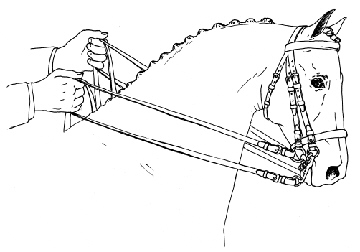
Double Bridle Reins – Fillis Method. The Fillis method of holding the reins is when the curb reins enter the rider’s hand from the bottom, around the little fingers and up to the second joint of the index fingers while the snaffle enters the fist from above over the index fingers. Each hand holds two reins.

